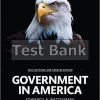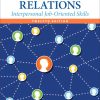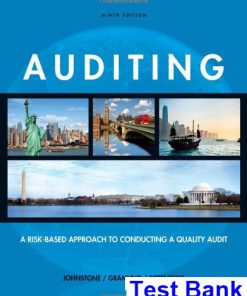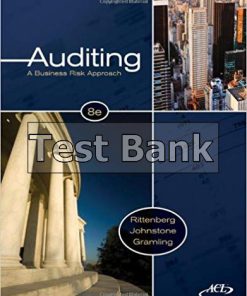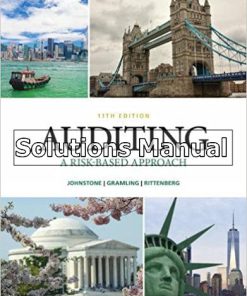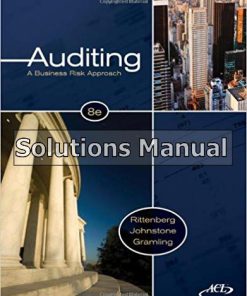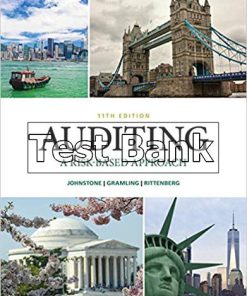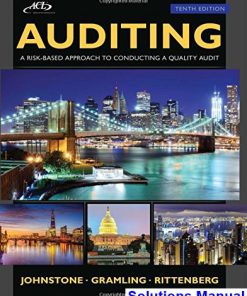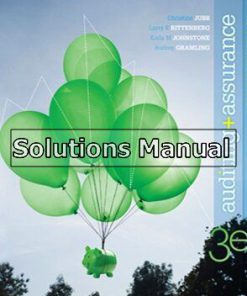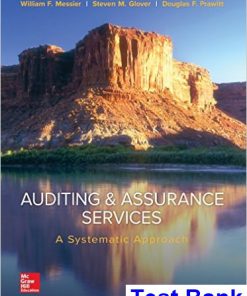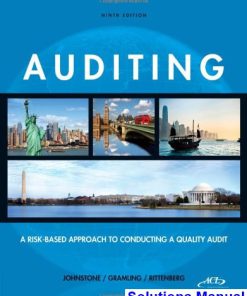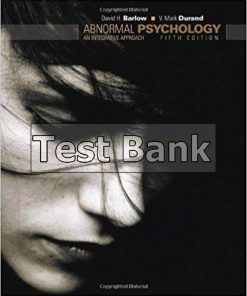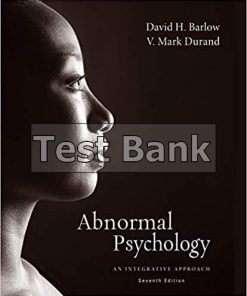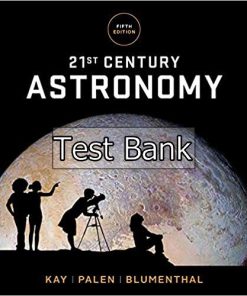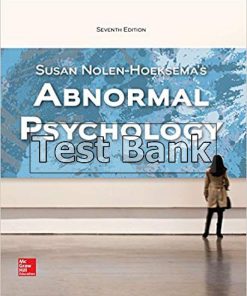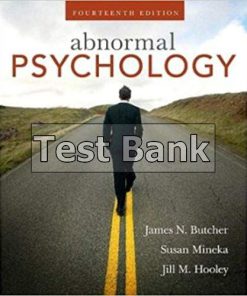Auditing A Risk Based-Approach to Conducting a Quality Audit 10th Edition Johnstone Test Bank
$50.00 Original price was: $50.00.$26.50Current price is: $26.50.
Auditing A Risk Based-Approach to Conducting a Quality Audit 10th Edition Johnstone Test Bank.
This is completed downloadable of Auditing A Risk Based-Approach to Conducting a Quality Audit 10th Edition Johnstone Test Bank
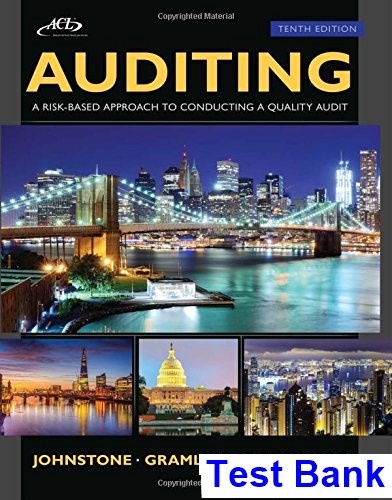
Product Details:
- ISBN-10 : 1305080572
- ISBN-13 : 978-1305080577
- Author: Karla M Johnstone-Zehms (Author), Audrey A. Gramling (Author), Larry E. Rittenberg (Author)
As today’s auditing environment continues to change in dramatic ways, those entering the profession must be prepared to handle a high standard of responsibility. You can prepare with the help of AUDITING: RISK-BASED APPROACH TO CONDUCTING QUALITY AUDITS, 10E. AUDITING reflects the latest clarified auditing standards and the newest PCAOB standards, while discussing the COSO’s Internal Control-Integrated Framework and the AICPA’s recently issued new audit sampling guidance. You’ll find the most recent professional developments with a new integrated emphasis on the latest fraud risks and ethical challenges throughout the book. New end-of-chapter problems as well as new cases provide valuable hands-on experience.
Table of Content:
- Ch 1: Auditing: Integral to the Economy
- Overview of the External Auditing Profession
- Audit Quality
- Achieving Audit Quality and Minimizing Lawsuits
- Client Acceptance and Continuance Decisions
- Summary and Next Steps
- Ch 2: The Auditor’s Responsibilities Regarding Fraud and Mechanisms to Address Fraud: Regulation and
- Fraud Defined
- The Fraud Triangle
- Recent History of Fraudulent Financial Reporting
- An Overview of the Auditor’s Fraud-Related Responsibilities and Users’ Expectations
- The Sarbanes-Oxley Act of 2002 as a Regulatory Response to Fraud
- The Post Sarbanes-Oxley World: A Time of Improved Corporate Governance
- Summary and Next Steps
- Ch 3: Internal Control over Financial Reporting: Responsibilities of Management and the External Aud
- Importance of Internal Control over Financial Reporting
- Defining Internal Control
- Components and Principles of Internal Control
- Management’s Responsibilities Related to Internal Control over Financial Reporting
- Importance of Internal Control to the External Audit
- Summary and Next Steps
- Ch 4: Professional Liability, Auditor Judgment Frameworks, and Professional Responsibilities
- The Legal Environment and the Effects of Lawsuits on Audit Firms
- Applicable Laws and Causes of Legal Action
- Auditor Liability under Contract Law, Common Law, and Statutory Law
- Auditor Liability under Statutory Law
- A Framework for Professional Decision Making
- A Framework for Ethical Decision Making
- Guidance on Professional Responsibilities and the Impact on Auditors’ Decisions
- Summary and Next Steps
- Ch 5: Professional Auditing Standards and the Audit Opinion Formulation Process
- Professional Auditing Standards
- The Audit Opinion Formulation Process
- Summary and Next Steps
- Ch 6: A Framework for Audit Evidence
- Obtaining Sufficient Appropriate Audit Evidence
- Appropriateness of Audit Evidence
- Type and Timing of Audit Procedures
- Sufficiency of Audit Evidence
- Additional Evidence Considerations
- Documenting Audit Evidence
- Summary and Next Steps
- Ch 7: Planning the Audit: Identifying and Responding to the Risks of Material Misstatement
- The Concept of Materiality
- Identifying and Assessing Risks of Material Misstatement
- Responding to Identified Risks of Material Misstatement
- Summary and Next Steps
- Ch 8: Specialized Audit Tools: Sampling and Generalized Audit Software
- Overview of Sampling and GAS as Tools for Gathering Audit Evidence
- Objectives of Sampling and Risks Associated with Sampling
- Nonstatistical and Statistical Sampling
- Attributes Sampling
- Using Sampling to Gather Evidence about Misstatements in Account Balances and Associated Assertions
- Using GAS to Obtain Evidence
- Summary and Next Steps
- Ch 9: Auditing the Revenue Cycle
- Significant Accounts, Disclosures, and Relevant Assertions
- Performing Risk Assessment Procedures in the Revenue Cycle
- Obtaining Evidence about Internal Control Operating Effectiveness in the Revenue Cycle
- Obtaining Substantive Evidence about Accounts, Disclosures, and Assertions in the Revenue Cycle
- Summary and Next Steps
- Ch 10: Auditing Cash and Marketable Securities
- Significant Accounts, Disclosures, and Relevant Assertions
- Performing Risk Assessment Procedures for Cash Accounts
- Obtaining Evidence about Internal Control Operating Effectiveness for Cash
- Obtaining Substantive Evidence about Cash Accounts, Disclosures, and Assertions
- Auditing Marketable Securities
- Summary and Next Steps
- Ch 11: Auditing Inventory, Goods and Services, and Accounts Payable: The Acquisition and Payment Cyc
- Significant Accounts, Disclosures, and Relevant Assertions
- Performing Risk Assessment Procedures in the Acquisition and Payment Cycle
- Obtaining Evidence about Internal Control Operating Effectiveness in the Acquisition and Payment Cyc
- Obtaining Substantive Evidence about Accounts, Disclosures, and Assertions in the Acquisition and Pa
- Summary and Next Steps
- Ch 12: Auditing Long-Lived Assets: Acquisition, Use, Impairment, and Disposal
- Significant Accounts, Disclosures, and Relevant Assertions
- Performing Risk Assessment Procedures for Long-Lived Assets
- Obtaining Evidence about Internal Control Operating Effectiveness for Long-Lived Asset Accounts and
- Obtaining Substantive Evidence about Accounts, Disclosures, and Assertions for Long-Lived Asset Acco
- Summary and Next Steps
- Ch 13: Auditing Debt Obligations and Stockholders’ Equity Transactions
- Significant Accounts, Disclosures, and Relevant Assertions
- Performing Risk Assessment Procedures for Debt Obligations and Stockholders’ Equity Transactions
- Obtaining Evidence about Internal Control Operating Effectiveness for Debt Obligations and Stockhold
- Obtaining Substantive Evidence in Auditing Debt Obligations and Stockholders’ Equity Transactions
- Summary and Next Steps
- Ch 14: Activities Required in Completing a Quality Audit
- Review Activities
- Communicating with Management and the Audit Committee (and Those Charged with Governance)
- Summary and Next Steps
- Ch 15: Audit Reports on Financial Statements
- Principles Underlying Audit Reporting
- Standard Unqualified Audit Reports on Financial Statements
- Unqualified Audit Reports with Explanatory Language
- Qualified Reports, Adverse Reports, and Disclaimers
- Comparisons of Modifications to the Standard Unqualified Audit Report
- Audit Reports on Internal Control over Financial Reporting
- Summary and Next Steps
- Ch 16: Advanced Topics Concerning Complex Auditing Judgments
- Complex Auditing Judgments
- Evaluating Misstatements
- Assessing Long-Term Liabilities Involving Significant Subjective Judgment
- Auditing Merger and Acquisition Activities
- Auditing Management’s Fair Value Estimates and Related Impairment Judgments
- Audit Considerations for Fair Market Estimates and Related Impairments
- Auditing Financial Instruments
- Evaluating a Client’s Internal Audit Function
- Summary and Next Steps
- Ch 17: Other Services Provided by Audit Firms
- Nonaudit Attestation Services Provided by Audit Firms
- Reviews and Compilations
- Reviews of Interim Financial Information for Audit Clients
- Special Considerations for Reporting
- Attestation on Agreed-Upon Procedures, Financial Forecasts and Projections, and Pro Forma Financial
- Forensic Accounting
- Sustainability Reporting and Assurance
- Summary
- ACL Appendix
- Auditing Standards Appendix
- Case Index
- Auditing in Practice, Emerging Issues & Focus on Fraud Index
- Index
People Also Search:
auditing a risk based-approach to conducting a quality audit
auditing a risk based-approach to conducting a quality audit 10th edition
auditing a risk based-approach to conducting a quality audit download scribd
auditing a risk based-approach to conducting a quality audit testbank download pdf
Instant download after Payment is complete
You may also like…
Accounting
Auditing A Risk-Based Approach to Conducting a Quality Audit 9th Edition Johnstone Test Bank
Accounting
Auditing A Risk Based-Approach to Conducting a Quality Audit 10th Edition Johnstone Solutions Manual
Accounting
Auditing A Risk-Based Approach to Conducting a Quality Audit 9th Edition Johnstone Solutions Manual


